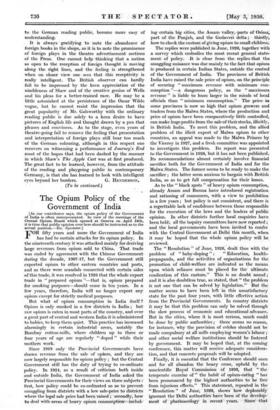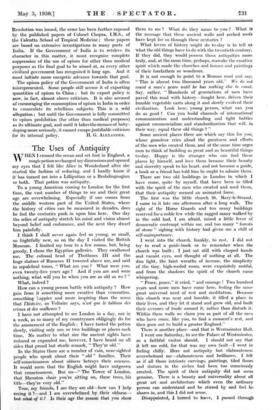The Opium Policy of the Government of India
[As our contributor says, the opium policy of the Government of- India is often misrepresented. In view of the meetings of the Central_ Opium. Board. which -opened- at Geneva on April 24th, it is time that public opinion over here should be instructed as to the actual position.—ED. Spectator.] 110R fifty years and more the Government of India has had to sustain attacks for its opium policy. In the nineteenth century it was attacked mainly for deriving large revenues from opium sold to China. That trade was ended by agreement with the Chinese Government during the decade, 1907-17, but the Government still exported opium to other eastern countries and ports,' and as there were scandals connected with certain sides of this trade, it was resolved in 1926 that the whole export trade in "prepared opium "—that is, opium prepared for smoking purposes—should cease in ten years. In a few years, therefore, India will no longer export any opium except for strictly medical purposes. - • But what of opium consumption in India itself ? Opium is only smoked in a few districts in India ; but raw opium is eaten in most parts of the country, and over a great part of central and western India it is administered to babies, to keep them quiet. This practice has increased alarmingly in certain industrial areas, notably the Bombay cotton-mills, where children up to three or four years of age are regularly " doped " while their mothers work.
Since 1919 only the Provincial Governments have drawn revenue from the sale of opium, and they are- now largely responsible for opium policy ; but the Central Government still has the duty of trying to co-ordinate policy. In 1924, as a result of criticism both inside and outside India, the Government of India - asked the Provincial Governments for their views on three subjects- first, how policy could be co-ordinated so as to prevent. smuggling from districts with a low sale-price to districts where the legal sale price-had been-raised; secondly, how to-deal witly-areas of heavy opium consiimption=2–includ-. ing certain big cities, the Assam valley,- parts of Orissa:, _part of. the Punjab, and the Godaveri delta ; thirdly; • bow to check the custom of giving opium to small children: The replies were published in June, 1926; together with a survey which embodies the most recent general state- ment of policy. It is clear from the replies that the smuggling nuisance was due mainly, to the fact that opium is produced in certain Indian States, outside the control of the Government of India; The provinces of British India have raised the sale price-of opium; on the principle of securing "maximum revenue with minimum con- sumption "—a dangerous policy, as the " maximum revenue" is liable to- loom larger in the minds -of local officials than "minimum consumption." The pricer in some provinces is now so high that opium growers and traders from the Malwa States, where the production and price of opium have been comparatively little controlled; can make -huge profits from the sale of their stocks, illicitly; in British India. To meet this problem, and the allied problem of the illicit export of Malwa opium to other countries, an appeal was made to the Malwa Princes by the Viceroy in 1927, and a fresh committee was appointed to investigate, this problem. Its report was presented to the Government in 1928, but it has not been published: Its recommendations almost certainly involve financial sacrifice both for the Government of India and for the Malwa States. The former seems to be ready to make the sacrifice ; the latter seem anxious to bargain with British India; so as to get full compensation for their losses.
As to the "black spots" of heavy opium consumption, already Assam and Burma have introduced registration and rationing of consumers, with a view to prohibition in a few years ; but policy is not consistent, and there ii a regrettable lack of confidence between those responsible for the execution of the laws and the leaders of public opinion. In other districts further local enquiries have been held; all the inquiry committees have now reported ; and the local governments have been invited' to confer'. with the Central Government at Delhi this month, when it may be hoped that the whole opium policy will be reviewed.
The " Resolution " of June, 1926, dealt thus with the' problem of "baby-doping": _" Education, health- propaganda, and the activities of organizations" for the promotion of child-arelfare are indicated -as the means Upon which reliance Must be placed for the ultimate eradication of this custom." This is no doubt sound ;' and it is also doubtless true, as stated, that "the problem: is not one that can be solved by legislation." But the matter seems to have been left in this unsatisfactory' state for the past four years, with little effective action , from the Provincial Governments. In'6ountry clkstricts it may be that this problem can only be solved through the slow process of economic and educational advance.
But in the cities, where it is most serious, much could be done by public authorities ; there seems no reason, for instance, Why the provision of &kites should not be Made compulsory at all mills employing women's labour ; and other social welfare institutions should be fostered by government. It may be hoped that; at the coming conference, this matter will receive adequate considera- tion, and that concrete proposals will be adopted.
Finally, it is essential that. the Conference should once and for all abandon the hoary error, upheld by the Unscientific Royal Commission of 1898, that "the temperate exercise of" the habit of opium-eating "has been pronounced by the highest authorities to be free from injurious effects." This statement, repeated in the " ResolutiOn " of June, 1926, shows how deplorably ignorant the Delhi authorities have been of the develop- ment of phaiinacology in .recent years. Since. that Resolution was issued, the error has been further. exposed by the published papers of Colonel. Chopra, I.M.S., of the Calcutta School of Tropical Medicine ; these papers are based on extensive investigations in many parts of India. If the Government of India is to. retrieve its character in this matter, it must recognize complete suppression of the use of opium for other than medical purposes as the final goal to be aimed at, as every other civilized government has recognized it long ago. And it must initiate more energetic advance towards that goal.
The opium policy of the Government of India is often misrepresented. Some people still accuse it of exporting quantities of opium to China ; but its export policy is now, in fact, almost above criticism. It is als6 accused of encouraging the consumption of opium in India in order to cmasculate its rebellious subjects. This is a wild allegation ; but until the Government is fully committed to opium prohibition (for other than medical purposes) as its ultimate goal; and until it takes-the menace of baby- doping more seriously, it cannot escape justifiable criticism















































 Previous page
Previous page